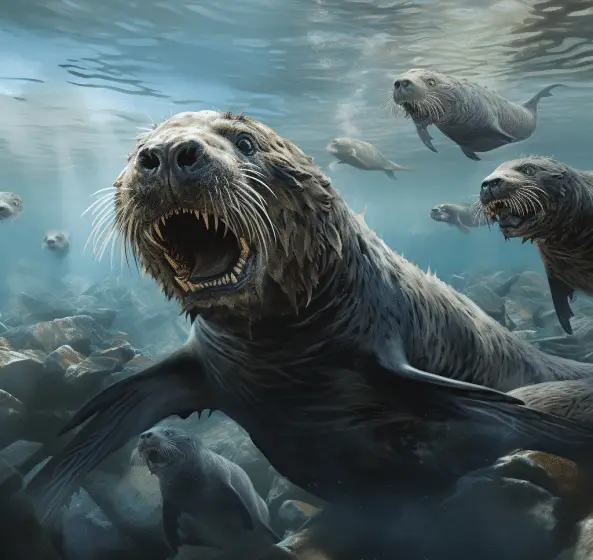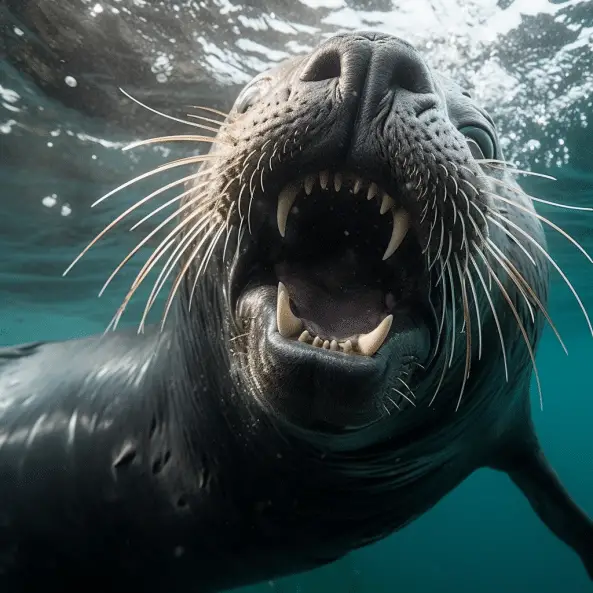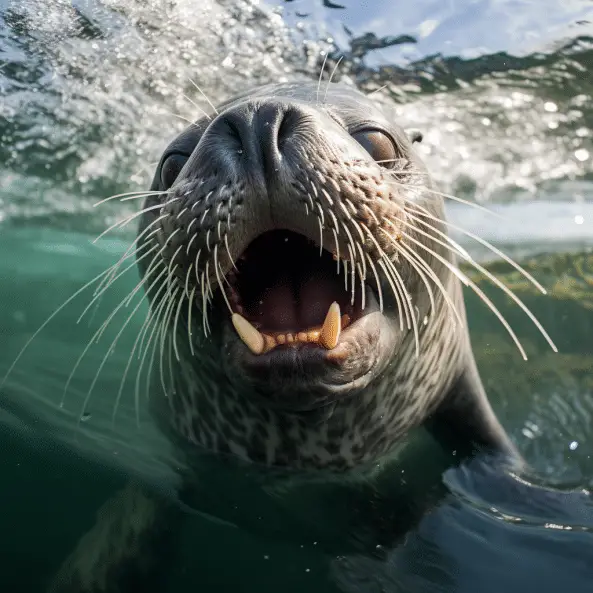Do Seals Have Teeth

Introduction
Seals have sleek bodies, amusing behaviors, and distinctive vocalizations. Do Seals Have Teeth? The answer to this seemingly basic question reveals more about these extraordinary creatures and their water-adapted lifestyles.
Seals, sea lions, and walruses are pinnipeds with flippers and semi-aquatic lives. Dentition, or tooth arrangement, is fascinating in marine biology.
Unlike some marine mammals that have lost their teeth altogether, seals have a diverse array of dental adaptations. The types and numbers of teeth vary among seal species, reflecting their specific dietary preferences and foraging behaviors. These adaptations provide valuable insights into their ecological roles and survival strategies.
We shall study seal teeth’ structure, function, and importance to these creatures. We will also discover how seals have adapted to their harsh underwater surroundings. Let’s explore these toothy marine marvels’ underwater worlds and discover their smiles.
Do all seals have teeth?
All seals have teeth, however species differ. Pinnipeds—seals, sea lions, and walrus—have 34 to 38 teeth, while humans have 32.
Most seal species have teeth, but some don’t. True seals, or phocids, make up most seal species and have sharp, predatory teeth. These teeth are vital for catching and eating aquatic prey.
The walrus is an oddity among seals. Walruses are odobenids with long tusks. Their extended teeth, or tusks, are used for hunting, defense, breaking ice, and lifting their heavy bodies onto ice floes. Walruses have smaller teeth in the back of their jaws, but their tusks are most notable.
Some seals, like the crabeater seal, have filter-feeding teeth. Instead of sharp teeth, they have comb-like features to strain krill and other small prey from the water.
Most seals have teeth, but their form and function vary by species, demonstrating their extraordinary adaptations.

How many teeth does a seal have?
Most seals have between 34 to 38 teeth, while some have a few less than 34 but nothing more than 38. Most seals have really sharp and pointed front teeth. Despite this fact, they do not use their front teeth for chewing. They focus on using the front teeth for grasping and tearing their food.
The number of teeth in seals can vary significantly depending on the species. The dental anatomy of seals is tailored to their specific dietary needs and hunting behaviors, which has led to a range of tooth arrangements.
True seals, also known as phocids, generally have fewer teeth compared to other seal types. They typically have sharp, conical teeth, with most species having around 32 to 34 teeth in total. These teeth are well-suited for grasping and tearing the fish and other prey that make up their diet. Some examples of true seals include the harbor seal and the Weddell seal.
However, Otariidae sea lions and fur seals have more teeth than phocids. They have 30–40 teeth, including canines for gripping and molars for grinding. These teeth reflect their larger diets, which may include fish, squid, and birds.
The walrus, albeit not a seal, is another exception. Its powerful tusks and 18–24 teeth help it hunt and break through ice.
Seals have 18–40 teeth, depending on species and food. The dental anatomical adaptations of these marine mammals show their extraordinary diversity.
Do baby seals have teeth?
It’s possible to see seal pups on beaches and it’s a wonderful thing to behold, but you should keep your distance and respect that these are wild animals; they have teeth like a dog and can inflict a nasty bite (even the pups).
Baby seals, also known as seal pups, go through a fascinating process of dental development that reflects their transition from birth into a world filled with aquatic challenges. The presence of teeth in baby seals varies depending on their species and their future dietary needs.
True seals, or phocids, typically give birth to pups with no teeth. These pups are initially dependent on their mother’s milk, and their diet consists exclusively of this nutrient-rich source during the early stages of their lives.
Sea lions and fur seals, which belong to the family Otariidae, give birth to pups with teeth already present. These pups have a set of deciduous teeth that facilitate a more immediate adaptation to a diet that includes fish and other prey. These milk teeth will eventually be replaced by permanent teeth as the pups grow.
The presence or absence of teeth in baby seals is a reflection of their family’s dietary strategies and the need to adapt to their specific ecological niches. It’s a fascinating aspect of their life cycle, showcasing the diversity in the world of these captivating marine mammals.
What does a seal tooth look like?
Take a look at the canines – the long, sharp, pointed teeth. You can definitely tell that seals are carnivores by looking at those canines! Carnivores are animals that eat meat (mostly fish, in this case), and their canines help them to do that. Those long sharp teeth are used to quickly grab prey and firmly hold it.
A seal’s tooth is a remarkable structure designed for specific functions related to its dietary habits and survival in its aquatic environment. The appearance of a seal’s tooth can vary greatly depending on the species, reflecting their adaptation to different niches within the marine world.
In true seals, or phocids, the teeth are generally conical and sharp. These teeth are well-suited for grasping, tearing, and puncturing prey. Their shape is reminiscent of a dog’s canine teeth and is specially adapted for catching and consuming a diet primarily consisting of fish, squid, and other aquatic animals.
Sea lions and fur seals, members of the Otariidae family, have teeth that exhibit a more complex structure. They have sharp canines at the front for gripping and tearing, along with molars toward the back for grinding. This reflects their broader dietary range, which can include a variety of prey like fish, squid, and even birds.
The walrus, while not a true seal, has impressive tusks that are elongated teeth used for various purposes, including hunting and breaking through ice.
A seal’s tooth structure is a testament to the diversity of their diets and their remarkable adaptations to their underwater world. The size, shape, and number of teeth vary among different seal species, each tailored to the specific demands of their environment and ecological niche.
What are 3 interesting facts about seals?
The Seals can dive to great depths underwater and stay there for up to two hours. Seals use clicking or trilling noises to communicate. Seals eat fish, birds, and shellfish. Male seals are called bulls; females are called cows; and babies are called pups. Here are three fascinating facts about seals:
Diverse Species and Habitats: Seals are a highly diverse group of marine mammals, comprising over 30 different species. They are found in a wide range of habitats, from the icy waters of Antarctica, where you find species like the leopard seal, to the warm coastlines of places like California, where harbor seals thrive. This diversity showcases their incredible adaptability to various environments.
Unique Locomotion: Seals are incredibly versatile in the water, employing a method of movement known as “undulatory locomotion.” Unlike fish, seals use their powerful flippers to propel themselves forward in a motion similar to a flying bird’s wing strokes. This graceful technique allows them to be agile hunters and expert navigators in their aquatic realms.
Vocal Communication: Seals are known for their intriguing vocalizations. Each species has its distinct set of calls and songs used for various purposes such as communication, mating, and maintaining territory. For example, male elephant seals are known for their deep, resonant roars that can carry over long distances. These vocalizations play a crucial role in their social interactions and survival strategies.
These facts highlight the remarkable diversity and adaptability of seals, as well as their fascinating behaviors and abilities in their natural habitats.
How powerful is a seal bite?
Mothers can abandon their pups or not feed them adequately, dogs may transmit diseases or chased distressed animals into the water and, of course, the seals, feeling cornered, may react by biting. When they do, it is serious: their bites are as strong as those of a Rottweiler.
A seal’s bite is a display of astonishing power, especially when considering their streamlined and graceful appearance in the water. The strength of a seal’s bite is primarily attributed to the robust musculature surrounding their jaws, combined with the sharpness and density of their teeth.
For instance, the formidable leopard seal, native to the Antarctic, possesses a particularly strong bite. With long, sharp canines designed for puncturing through tough prey, a leopard seal can exert a force of over 450 pounds per square inch (psi) when biting down. This incredible bite force enables them to effectively capture and subdue a variety of prey, including penguins, fish, and even other seals.
Other seal species also exhibit notable biting capabilities, tailored to their specific dietary preferences. Whether it’s the harbor seal’s proficiency in consuming a diverse range of fish or the elephant seal’s dominance in tackling larger prey, each species showcases adaptations that have honed their biting strength.
While seals are renowned for their agility and grace in the water, their powerful bites serve as a reminder of the remarkable diversity of strategies that have evolved in the animal kingdom for survival and predation. These adaptations are a testament to the ingenuity of nature’s designs.
How strong are seals teeth?
Generally, seals have very sharp teeth. Even the molars on seals are razor-sharp. They don’t chew their food like we do which is why their molars aren’t flat. They can grab and rip apart fish that are too large to be swallowed whole using those pointed teeth.
A seal’s teeth are remarkably strong and well-adapted to their marine lifestyle. The strength of a seal’s teeth is primarily derived from their composition and shape. Composed primarily of dentin, a dense calcified tissue, and enamel, seals’ teeth are designed for both cutting and gripping. This robust dental structure allows them to efficiently catch and consume a variety of prey, ranging from fish to crustaceans.
Additionally, seals’ teeth are self-sharpening. The constant friction between their upper and lower teeth during feeding helps maintain their sharpness. This adaptive feature is crucial for sustaining their hunting capabilities over time, even in the harsh conditions of the ocean.
One of the most striking examples of powerful seal teeth can be found in the leopard seal. This species boasts notably long and sharp canines, which play a pivotal role in capturing and dispatching their prey. With teeth capable of puncturing through thick blubber and tough scales, leopard seals exemplify the formidable strength that some seals possess in their dental anatomy.
Overall, the strength of a seal’s teeth is a testament to the marvels of natural adaptation. It enables these marine mammals to thrive in their challenging underwater environments, ensuring their survival in the intricate web of marine ecosystems.
What seal has long teeth?
Leopard seals
Leopard seals use their powerful jaws and long teeth to kill smaller seals, fish, and squid. These effective predators live in frigid Antarctic and sub-Antarctic waters, where they also eat penguins.
The seal with long teeth is commonly known as the leopard seal (Hydrurga leptonyx). This formidable predator, native to the frigid waters surrounding Antarctica, possesses a set of impressive dental armament. Its name derives from the distinctive spotted pattern on its coat, resembling that of a leopard. However, it’s the leopard seal’s dental features that truly set it apart. The canines of the leopard seal are notably long and sharp, a characteristic that grants it a fearsome reputation in the marine ecosystem.
These formidable teeth serve a crucial purpose in the seal’s predatory lifestyle. They allow the leopard seal to efficiently catch and devour a diverse array of prey, including fish, squid, and even other seals. With streamlined bodies and powerful flippers, they are agile swimmers, capable of chasing down their quarry with remarkable speed. The combination of their teeth, sleek physique, and exceptional hunting skills makes them a top-tier predator in the Antarctic food chain.
Beyond their prowess as hunters, leopard seals are known for their solitary nature and distinct vocalizations. Their haunting, melodic calls reverberate through the icy expanses, adding an ethereal quality to the Antarctic’s austere beauty. Despite their awe-inspiring presence, these creatures face their own set of challenges, primarily from the rapidly changing climate and diminishing sea ice. Preserving their habitat is crucial not only for the survival of the leopard seal but also for the delicate balance of the Antarctic ecosystem as a whole.

Conclusion
Seals’ teeth vary across species, reflecting the diverse dietary niches they occupy. From the sharp, carnivorous teeth of the harbor seal to the filter-feeding adaptations of the crabeater seal, these animals have evolved to master their respective ecosystems. Their teeth are crucial tools for catching prey, crushing shells, and even filtering krill from the water.
Seal teeth provide valuable insights into the ecological balance of marine environments. Studying the dental adaptations of these creatures allows us to comprehend their roles as predators, prey, and key components of the ocean’s food web. These adaptations are also vital to their survival, ensuring their continued existence in the face of environmental challenges.
The study of seal teeth reveals a captivating dimension of marine biology. Beyond their charming appearances and playful behaviors, seals are masters of dental adaptation, showcasing the incredible diversity of seals life on our planet. So, the next time you encounter a seal, remember that behind their smiles lies a story of evolution and resilience in the world’s vast and dynamic oceans.



